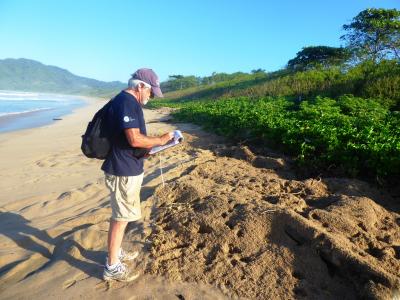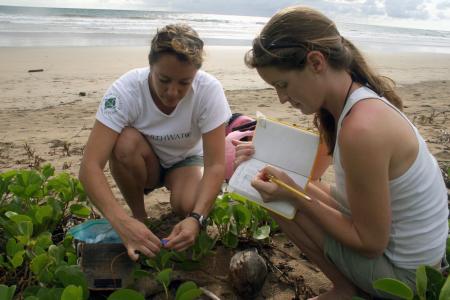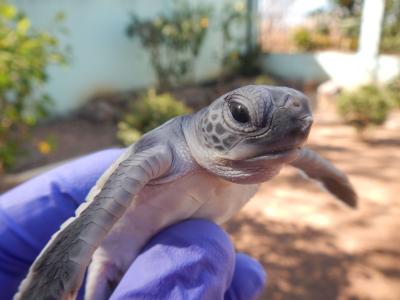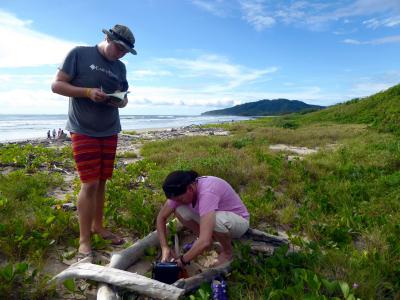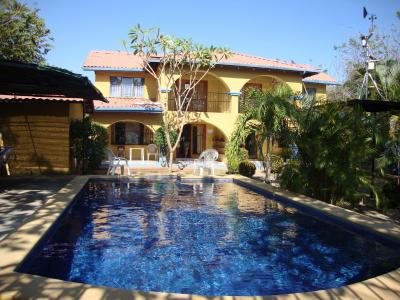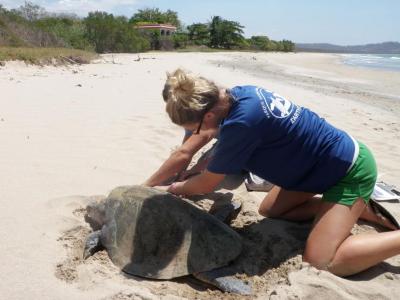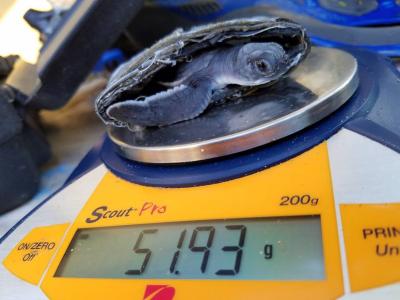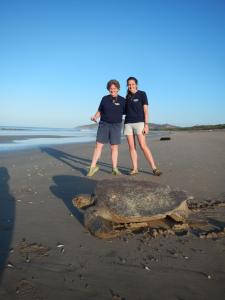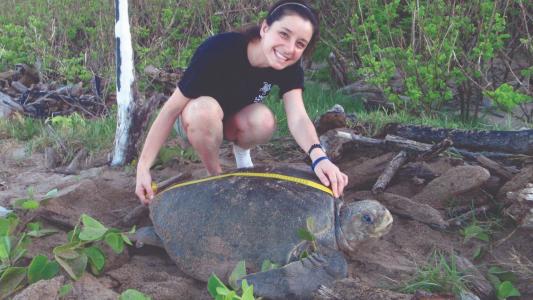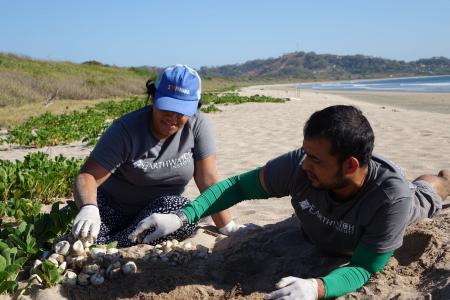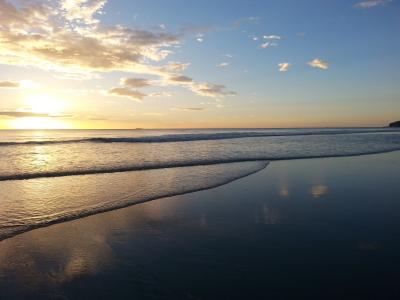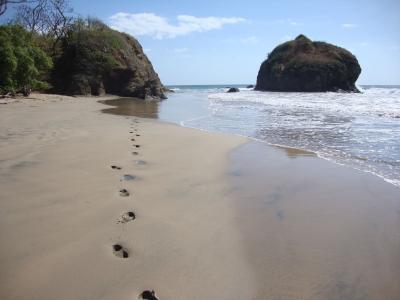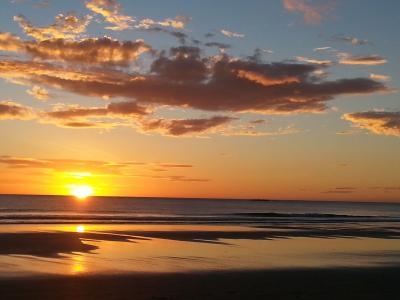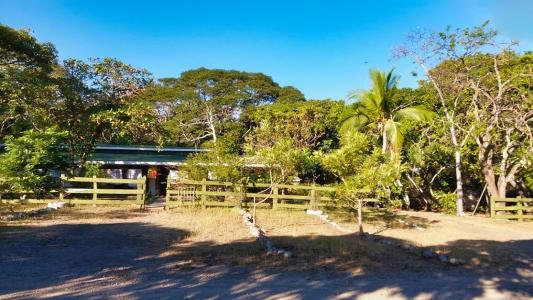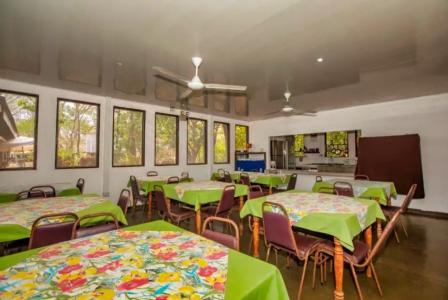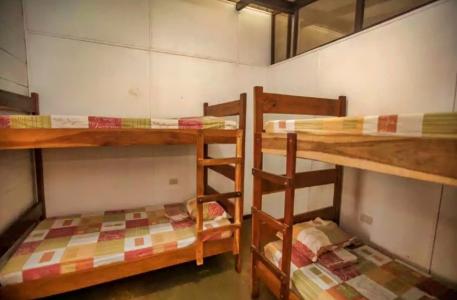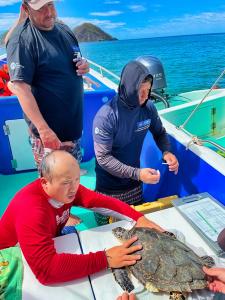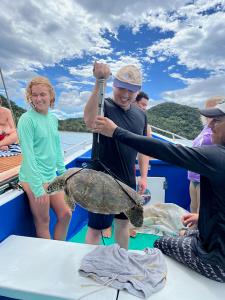.
Please read the following information before leaving for your expedition.
It provides the most accurate information available and will likely answer any questions you have about the project. You may also reach out to your Program Coordinator with any questions you may have.
Click on the images to view full size!
COVID-19 SAFETY
Please test for COVID-19 before traveling to your expedition. If you have tested positive, do not travel, and call Earthwatch immediately for the next steps. Visit earthwatch.org/covid-19 for more information on how you can help reduce the risk of COVID-19 impacting your expedition.
Important Notice: The field stations hosting your expedition have several additional policies to control COVID-19 transmission. As Earthwatch participants, you will be required to comply with these policies, including:
- Participants must take a SARS-CoV-2 antigen test (home test) on the day of travel to the expedition (i.e., before boarding the flight to Costa Rica). If you are traveling in Costa Rica before meeting your team, testing should be conducted on the rendezvous day before joining the group.
- Participants must travel with and self-administer a SARS-CoV-2 antigen test (home test) once again on Day 3 of the expedition (three days after arrival). You will be instructed to wear a mask when entering the biologists’ side of the field station until a negative test result is obtained on Day 3. KN95 (FFP2) or KN94 masks are strongly recommended. Masking will not be required at the volunteer lodging. Additional testing may be required should an individual exhibit symptoms consistent with COVID-19 during the expedition.
The Research
The project began in 1988 with the goal of protecting and monitoring the population of leatherback turtles (Dermochelys coriacea) that nested within what is now Parque Nacional Marino Las Baulas. The leatherback turtle is the largest of all sea turtles, growing up to lengths of 3 meters (9 feet) and weighing as much as 916 kilograms (2,020 pounds). The leatherback turtle received its name from its carapace (shell) that, unlike other sea turtles, is made of leathery skin, not bone. They are also more widespread than other sea turtles because their large size allows them to maintain body temperature, a trait researchers call gigantothermy. Gigantothermy allows leatherback turtles to inhabit all the world's oceans except for the polar oceans.
When the project began, and before the establishment of Las Baulas National Marine Park, almost all the leatherback nests laid on Playa Grande were poached by humans who removed the eggs for consumption. Poaching was effectively eliminated in the early 1990s with the establishment of Las Baulas National Marine Park, but a number of other threats to the survival of the leatherback turtles have now arisen, including incidental capture by commercial fisheries (Roe et al. 2014), boat strikes, predation of nests by invasive dogs and raccoons, and climate change (Santidrián Tomillo et al. 2012, Saba et al. 2012). In addition, leatherbacks frequently ingest plastic bags as they look deceptively like their main food source: jellyfish. On this project, researchers continually strive to discover and implement new methods to eliminate and/or mitigate the threats faced by the leatherback turtles in the Eastern Pacific Ocean.
Since then, the program scope has expanded to include the East Pacific green (Chelonia mydas) and olive ridley (Lepidochelys olivacea) turtles that nest alongside leatherbacks in Las Baulas National Marine Park. In tandem, the team has added two additional research sites in Costa Rica’s Guanacaste province—including Playa Cabuyal and Bahía Matapalito. In Cabuyal, researchers study the ecology and biology of the green, olive ridley, and leatherback sea turtle populations that nest there, particularly the green turtles. East Pacific green turtles are a morphologically distinct population of green turtles that only nest in the East Pacific, from Mexico down through Central America and west to the Galapagos Islands, Ecuador. Colloquially, these turtles are called black turtles due to their darker coloration; however, they also have a distinct carapace shape, are smaller in size, and have a lower reproductive output compared to the other green turtle morphotype (Álvarez-Varas et al. 2021a).
Bahía Matapalito is located adjacent to Santa Rosa National Park and is a foraging habitat for black turtles, green turtles, olive ridley turtles, and hawksbill turtles. In Bahía Matapalito, juveniles and adults spend their time resting and eating (Heidimeyer et al. 2014). Thanks to its unique winds, currents, and topography, Matapalito is one of the few places in Costa Rica that can support the herbivorous diets of green turtles, the omnivorous diets of black turtles, and even hawksbill sea turtles, who are thought to only eat sponges as adults (Clyde-Brockway et al. 2022). Habitats like Matapalito are crucial to ensuring that juvenile green and hawksbill turtles survive to adulthood and can reproduce.
The team maintains a long-term database on the population biology and nesting ecology of leatherback turtles nesting on the beaches in the national park complex where you will work—one of the longest population datasets for sea turtles worldwide! The data collected through this project are used to produce peer-reviewed scientific publications and to develop new policies and protections for sea turtles. The project also contributes to the training of Costa Rican scientists and supports the conservation work of the local community. This research has been instrumental in establishing and maintaining the Las Baulas National Marine Park and the Goldring-Gund Marine Biology Field Station. Additionally, it led to a management plan for the entire area that impacts all land development and water use. This national park is now being used as a beach protection and preservation model in Costa Rica and throughout Central America. In addition, the project is part of the Laúd OPO network (savepacificleatherbacks.org) and collaborates with all countries in the Eastern Pacific to protect leatherback turtles throughout the region, both on the nesting beaches and in the ocean.
Recent years have shown a dramatic decline in the number of nesting leatherbacks recorded, with some teams reporting zero throughout their time in the field (although they have seen other turtle species nesting). Scientists and policymakers need this information to understand the impacts of poaching, fisheries by-catch, beach development, and pollution over time. In addition, researchers now have sufficient data to assess the impacts of climatic processes on the reproductive behavior and success of sea turtles. This information has led to current experiments aiming to mitigate the adverse effects of the warming climate on sea turtle nests. It has helped to create an updated nest protection protocol to be used as a model for other sea turtle projects.
Research Aims
On this project, researchers aim to inform and improve conservation management strategies for Eastern Pacific sea turtles by continually uncovering more about the secret lives of these majestic animals. Research focuses on these general hypotheses:
- The Las Baulas National Marine Park and the existing management plan are effectively protecting the population of leatherback turtles found nesting in Playa Grande;
- Climate change and seasonal oceanic variations are impacting the nesting and foraging populations of marine turtles at all project locations;
- Conservation of sea turtles outside Protected Areas can improve the chances of survival;
- Bahía Matapalito, Playa Cabuyal, and Las Baulas National Marine Park are important habitats for a variety of marine turtle species and encompass a wide range of life cycle stages.
The main objective is to continue the population study of leatherbacks and other sea turtle species that nest at Las Baulas National Marine Park, Playa Cabuyal, and Bahía Matapalito. This involves conducting research on their nesting ecology, foraging ecology, physiology, and behavior. This project also applies and assesses the effectiveness of protection measures and factors that may affect the population, such as development, the presence of marine debris, light pollution, and predation.
The team also works to involve the local community in these research and conservation efforts—including running a program to educate school children on the benefits of turtles and the area's natural resources. Further, through ongoing “Lights out” and “No straw, please” campaigns, the team aims to educate visitors and locals about threats turtles face due to environmentally harmful human practices. Through the creation and support of local guide and artisan cooperatives, the project contributes to the livelihoods of local communities. Overall, the team has helped to foster a sustainable local economy that works in harmony with the management and protection of the Las Baulas National Marine Park and sea turtle species, and they look forward to ushering you into the community.
How You Will Help
On the first day, you will be oriented on how to assist the scientists in working with the turtles on the beach. In the evenings, informal presentations about the main project, other research projects, and the need for conservation may be given before the activities.
IN THE RESEARCH PORTION OF THE PROJECT, YOU WILL BE WORKING MAINLY AT NIGHT. POSSIBLE ACTIVITIES INCLUDE THE FOLLOWING:
- Walking the beaches of Playa Grande and Playa Cabuyal in search of nesting turtles and recording data on their nests. The number of leatherback, green, and ridley turtles seen per night varies, and you may walk up to 8 miles over 6 hours during the shift. Typically, participants will see anywhere from 0 to 5 turtles during walks—no turtles may be seen on some nights.
- Collecting eggs from newly laid clutches in danger of tidal inundation or predation by mammals (especially raccoons) for relocation to the hatchery (depending on the season).
- Assisting in scanning and reading the tags (PIT or metal, depending on the species) of all nesting females and measuring their carapace length and width.
- Counting eggs as the turtle lays them within the egg-chamber.
- Helping to check each turtle for scars from boat strikes or interactions with fishing gear. If necessary, removing any hooks found.
- Recording data
POSSIBLE DAYTIME ACTIVITIES INCLUDE THE FOLLOWING:
- Walking the beaches of Playa Grande and Playa Cabuyal at dawn to verify the number of nesting turtles from the night before (approximately 6 miles (10 km); 2 to 3 hours).
- Taking nest temperatures and recording the location of nests.
- Carrying equipment and assisting in excavating hatched nests to obtain data on hatching success.
- Cleaning equipment, preparing tags, packing for the next night’s activities, and possibly getting involved with other research projects, depending on the expedition.
- Traveling by boat to Bahía Matapalito to conduct research on Pacific green turtles and hawksbill turtles. Participants will assist researchers in collecting data on turtles that are netted and brought onboard the boat. This includes taking measurements, scanning turtles for pre-existing tags, and weighing juvenile turtles.
- *Helping attach radio, acoustic, or satellite transmitters and other bio-logging devices onto adult and hatchling sea turtles.
- *Collecting tissue samples or blood samples from adult and hatchling turtles for use in genetic or molecular analyses.
- *Analyzing footage from camera traps used to assess the biodiversity of nearby mangrove forests.
- *Assisting with the local education program, which includes schoolchildren's visits to the beach and hatchery. These activities are strictly dependent on the school schedule and timing.
*These activities do not happen on every team. If such activities are planned during your stay, you will be informed upon arrival.
Life in the Field
PHOTOGRAPHY AND LIGHT POLICY
Research activities will primarily take place at night. Bright lights disturb sea turtles and disorient hatchlings, which can be deadly. Nesting females may return to the ocean without nesting, and young hatchlings may die from exhaustion and/or get predated because they don't find their way to the sea. These concerns have caused many governments to impose very strict rules for light management on sea turtle nesting beaches.
The following rules apply to your expedition:
- Photography is NOT allowed on nesting beaches at night. Therefore, cameras are NOT allowed on nesting beaches at night. This even includes cameras with high-speed film and no flash, as well as smartphones.
- If you are a professional photographer and are interested in taking photos for a project, you must apply for a government permit. You must contact us at least 45 days before the expedition, as this can be a lengthy and arduous process.
- The project staff creates a shared folder each year containing photos from the current season that they will happily share with you. Proper copyright acknowledgment must be given at all times.
- Flashlights and headlamps: Only red light is allowed on the beach at night. If you need a red filter for your light appropriate for beach work, the project will supply it. If you have your own red headlamp, we recommend bringing it. To preserve the serenity of the nesting habitat, flashlights will only be used when necessary for research tasks and cannot be used to aid in walking along the beach.
The restrictions mentioned above only apply during nighttime activities. Photographs can be taken during all daytime activities, including nest excavations, morning walks, and turtle handling in Matapalito. There is also a small chance of seeing a daytime nesting turtle. If this happens, it is highly recommended that you bring your camera to this once-in-a-lifetime experience, keeping in mind that all photography needs to adhere to Park regulations and/or permit guidelines (e.g., no selfies with the turtle allowed), which the research team will explain.
ALCOHOL POLICY
It is the policy of the National Parks that volunteers who have consumed ANY amount of alcohol* during the day cannot be permitted on the beach to participate in that evening’s turtle survey or on the boat for their safety and the safety of the turtles. Please respect this policy.
If you plan to join the evening survey, do not consume alcoholic beverages during the day—not even a single beer or glass of wine at lunch. If you do consume alcohol during the day, you will be ineligible to resume surveys until the next morning and will not be permitted on the research boat.
*Minors (under age 18) are prohibited from consuming alcohol during the entire expedition, as per local law and Earthwatch policy.
MONEY MATTERS
Local Currency: Costa Rican colón. US dollars are accepted almost everywhere (though you will receive change in colónes).
Personal Funds: Credit cards are accepted in the region at all supermarkets and shops, however local pop-up artisanal craft stalls and street food options only take cash. It is recommended that you carry a small amount of cash for souvenirs and other incidental expenses. The airport should have an ATM, as should all medium-sized towns.
ITINERARY
Weather and research needs can lead to changes in the daily schedule. We appreciate your cooperation and understanding.
- Day 1—Arrival and Orientation: After meeting the team at the Goldring-Gund Marine Biology Field Station, the project staff members will introduce themselves and provide an orientation talk. They will guide you in what to expect regarding park and field station regulations and rules, safety, eating arrangements, daytime activities, night work on the beach, and recreational time. That night, the biologists will take you out on your first night patrol, and hopefully, you will see your first nesting sea turtle for the expedition!
- Days 2–4—Fieldwork at Playa Grande: Work and activities will be posted at the station, and you will often work in small groups. An estimated schedule follows:
- Night: We will spend six hours on the beach per night, arriving three hours before high tide and staying for three hours past high tide. You will walk the beach with your team members to collect data on each nesting female observed. From November to mid-December, we may relocate nests into the hatchery, and from mid-December to February, we monitor nests in the hatchery and then release the hatchlings after seeing them emerge from the nest. Depending on the tide, we will leave the beach between 12:00 a.m. and 5:00 a.m. If necessary, the night work is completed in two shifts (7:00–12:00 and 12:00–5:00).
- 5:30 a.m.–10:00 a.m.: Volunteers on morning beach surveys will leave around 5:00 a.m. You will walk up to 6 miles (10 km) while counting nests, fixing markers, and doing other fieldwork.
- 11:00 a.m.–Breakfast: We eat together each day, discuss the previous night's turtles, and plan for the day. You can walk the quarter mile to Kike’s (the restaurant where we have most meals) or go in the project van.
- 12:30 p.m.–3:00 p.m.: You will generally have free time during this period. We organize activities for volunteers to go on tours and other excursions that we offer. These depend on availability but may include a tour of a local estuary or snorkeling and swimming at Playa Carbón.
- 3:00 p.m.–5:00 p.m.: Those visiting nests to measure temperatures leave at 3:00 p.m. and work for a few hours on the beach. Other groups will fix markers and perform any hatchery maintenance work. Maintenance work on the hatchery and excavation of hatchery nests will be done during the afternoon. If nests are found the previous night, nest marking, relocation, and excavations will occur. These duties typically take one or two hours.
- Other work relating to student projects will occur as needed and be posted along with other daily activities.
- 6:00 p.m.: The team will dine together each night at Kike’s restaurant. Some evenings, either before or after dinner, depending on the work schedule, a staff member will present a slideshow or give an informal talk on the research.
- Days 5–7—Fieldwork at Playa Cabuyal: On Day 5, the team will travel overland approximately two hours northeast to Los Horizontes Station, Playa Cabuyal. After an orientation to the field station, night and day beach surveys will continue following a similar schedule as above, with teams breaking for meals at the station’s cafeteria.
- Day 8—Day Trip to Bahía Matapalito in Santa Rosa National Park: The team will travel overland (about two hours) to the fishing village of El Jobo to board the research boat. Participants will help to tag and measure juvenile turtles that forage in the bay. Turtles are collected by hand and using tangle nets, and volunteers may assist with in-water capture by swimming and snorkeling alongside the boat. The team will return to the Goldring-Gund Marine Biology Field Station in the evening for a wrap-up dinner and a trip to a beautiful spot to enjoy a breathtaking Costa Rican sunset. The return trip is about a 2.5 to 3-hour drive.
- Day 9—Departure: It is best to arrange late morning flights because you may be on the beach until early morning. It is impossible to stay at the accommodations past 2:00 p.m. on the day of departure.
Accommodations and Food
* Please note that not every expedition has couples’ or singles' accommodations available. Please call or email Earthwatch to check availability before reserving your space(s) on the team.
During the expedition, your team will stay at two locations: the Goldring-Gund Marine Biology Field Station at Playa Grande and the Los Horizontes Station at Playa Cabuyal.
Goldring-Gund Marine Biology Field Station
The Goldring-Gund Marine Biology Field Station is just behind the Playa Grande beach. You’ll have access to a kitchen, dining area, and lounge/classroom area there. You can also enjoy a number of amenities in your free time. The freshwater swimming pool at the station is open during the day, and the beach, only 25 meters away, provides a pleasant spot to relax during your time off. One hammock will also be set up to hang at the station. We have a large library of paperback books. Many visitors also take walks through the local habitats to bird watch.
You may do laundry by hand in an outside washbasin, but keep in mind that things dry very slowly due to the humidity (especially in November–December). A laundry service can also be provided for a fee (typically about US$3–5 for a small bag of clothes).
The local area experiences nominal rainfall from December to February. Water restrictions are in effect during this dry season (November to March), and all volunteers are asked to conserve water whenever possible. This may include shorter showers and restrictions on washing clothes.
Los Horizontes Field Station
Los Horizontes is a facility run by the Costa Rican Parks Service, located a short drive from Playa Cabuyal. Please keep in mind that the facilities are much more rustic and have fewer amenities than those at Goldring-Gund, but the station is well-situated for easy access to the beach.
SLEEPING
* Earthwatch will respectfully and without judgment honor each person’s assertion of gender identity. For both teen and adult teams, where logistics dictate single-sex accommodations or other facilities, participant placements will be made in accordance with the gender identity the participant specified on their Earthwatch Participant form and/or preferences indicated in discussions with Earthwatch.
Goldring-Gund Marine Biology Field Station
The station has three bedrooms for volunteers. When possible, people of the same gender will share these rooms, or they will be used to accommodate couples. The number of volunteers per room will depend on the team size. Each room has bunk beds. Privacy in the house is limited and depends on the number of volunteers at the station. The facilities are air-conditioned.
Los Horizontes Field Station
Volunteers will be accommodated in shared rooms in rustic dormitories with bunk beds. There are fans in the bedrooms, but no air conditioning. Participants are advised to bring and use a mosquito net at this location, as mosquitos and other insects can sometimes enter the dormitories. See the Packing List for specific recommendations. Field staff will help you install your net upon arrival.
Participants are encouraged to use the bottom bunk in the dormitories whenever available, as top bunks are not equipped with rails. Depending on the number of participants and the gender makeup of teams, there may be occasions when participants are required to utilize the top bunk.
Availability of couples' accommodations will be based on the gender makeup of the team.
BATHROOMS
Goldring-Gund Marine Biology Field Station
The station has two bathrooms for volunteers, each with a toilet, hot water, and a spacious shower. Sinks and mirrors are located outside the toilet areas. Both bathrooms are unisex and shared by everyone.
Los Horizontes Field Station
Facilities users share basic bathrooms with flush toilets and showers. Hot water is not available.
ELECTRICITY
At both stations, you can charge digital cameras or other electronic equipment. The voltage is 120, 60 hertz, generally with flat two-pin plugs and some three-pronged plugs.
PERSONAL COMMUNICATIONS
Both stations have a wireless Internet connection. You may bring your laptop, but participants are cautioned to take responsibility for any expensive equipment brought along.
Telephone Dialing Codes: When calling Costa Rica from an international phone, dial 00506 and then the number. When calling within Costa Rica from a domestic line, omit the 506 and dial the local number. When calling another country from Costa Rica, dial 00, followed by the other country’s country code (e.g., 1 for the U.S. and 44 for the U.K.) and the number. Please Note: all landline phone numbers in Costa Rica are preceded by a 2, and all Costa Rican cell phone numbers are preceded by an 8 (following the country code 506 if necessary).
Check with your cell phone provider to obtain any carrier-specific dialing codes you may need; many providers have dialing procedures that differ from these directions.
Please note: Earthwatch encourages volunteers to minimize outgoing calls and immerse themselves in the experience; likewise, family and friends should restrict calls to urgent messages only. Emergency communications will be prioritized.
FOOD AND WATER
Goldring-Gund Marine Biology Field Station
Teams will eat breakfasts and dinners at Kike’s Place, a local restaurant about a quarter mile away from the field station, but we typically will not have sit-down lunches. If you wish to make something to eat at lunchtime, some staples will be provided at the station. Volunteers on past expeditions have generally found that two meals per day are sufficient.
Los Horizontes Field Station
While at Los Horizontes, teams will eat breakfast, lunch, and dinner at the cafeteria. Please note that offerings are more limited in the cafeteria at Los Horizontes Field Station than at Kike’s Place Restaurant near Goldring-Gund.
TYPICAL MEALS
The following are examples of foods you may find in the field. Variety depends on availability and location. We appreciate your flexibility.
- Breakfast: Fruit, pancakes, eggs, vegetables, toast, French toast, omelets, and rice and beans. Fresh fruit smoothies are also available.
- Lunch: You might want to bring your own snacks to eat between breakfast and dinner. Basic food items such as sandwich materials, fruit, cookies, crackers, and cereal will be available at each station.
- Dinner: Vegetables, rice, beans, salad, meat, poultry, fish, pizza
- Snacks: You may prepare sandwiches, cookies, crackers, cereal, biscuits, etc. (a small grocery store near Goldring-Gund sells food and bottles of water inexpensively).
- Beverages: Fruit juices, coffee, soft drinks, and water. The tap water is potable, and we encourage drinking tap water over bottled water to reduce plastic consumption and aid in our conservation mission. Please bring two water bottles you can refill and carry in the field.
SPECIAL DIETARY REQUIREMENTS
Please alert Earthwatch to any special dietary requirements (e.g., diabetes, lactose intolerance, nut, other food allergies, vegetarian or vegan diets) as soon as possible and note them in the space on your volunteer forms.
Local dishes tend to include meat and fish, and while vegetarian meals are usually available, the restaurant and Los Horizontes cafeteria can’t offer much variety. Vegan meals can be more difficult to arrange, depending on availability. If you prefer several small meals or need snacks, you may wish to bring your own supply to supplement the menu.
Project Conditions
The following information is as accurate as possible, but please remember that conditions may change.
Temperatures are usually in the mid-80s to upper-90s°F (30–35°C) during the day but cool off significantly in the evening, usually to about 60°F (20°C). The rainy season runs from July to mid-November, with dry, hot, and windy conditions for the rest of the year. Volunteers on expeditions in November will experience rain and high humidity, so we recommend a light rain parka and a light, long-sleeved sweatshirt for cooler nights. The dry season extends from December to the end of March, when it tends to be warm, windy, and dry. Rolling hills and grassland surround the beach.
GENERAL CONDITIONS
You can visit wunderground.com and search for your project location for weather and region-specific information.
Essential Eligibility Requirements
All participants must be able to:
- Move in soft sand for most of the night (walking approx. 6 hours per night, with total distances up to 8 mi/12km). This activity is quite strenuous and may occur under difficult conditions (high tides, rain, high humidity, etc.) Consider doing preparatory back, calf, and thigh strengthening exercises before participating. See the packing list for suggested footwear for these walking conditions.
- Enjoy being outdoors and tolerate all types of weather.
- Endure tropical (hot and humid) work conditions and the presence of insects and other wildlife.
- Shift their sleep cycles throughout the expedition; we will work through the night and catch up on sleep during the daytime.
- Stay with the team and avoid obstacles while patrolling the beach in the dark or very low (moon) light.
- Communicate with team leaders and fellow team members by voice rather than visually, in the dark or very low light.
- If and when needed, get low to the ground, often on one’s knees or belly, to excavate turtle nests.
- Climb into and down out of a minibus and ride, seated with the seatbelt fastened, for 2–4 hours at a time when moving between research sites.
- Enter/exit a small boat from the beach in ankle- to knee-deep water. This includes stepping up and into the boat approximately 2 ft (0.5 m) off the ground without the assistance of a ladder (applies to Bahía Matapalito day trip only).
- Spend 6–8 hours sitting on a boat (some may experience seasickness) with only access to a bucket on the boat to relieve yourself (applies to Bahía Matapalito day trip only)
- *Swim/snorkel for up to 10 minutes at a time in areas where it is impossible to stand on the bottom; total swimming distance of approx. 150 ft (50 m) per session (Optional; applies to Bahía Matapalito day trip only)
- Follow verbal and/or visual instructions independently or with the assistance of a companion.
- Take an active role in one’s safety by recognizing and avoiding hazards if and when they arise (including, but not limited to, those described in Earthwatch materials and safety briefings). Always comply with project staff instructions and recommended safety measures.
- Be able to effectively communicate with the staff if they are experiencing distress or need assistance.
- Be able to get along with a variety of people from different backgrounds, often in close proximity, for the duration of the team.
- Be comfortable being surrounded by a language and/or culture that is not your own.
*Swimming on this expedition is optional for both recreational and research purposes. Confident swimmers may assist in the capture of turtles at Bahía Matapalito. Those who do not wish to swim may stay onboard the boat and assist with tagging and data collection once turtles are netted.
Health and Safety
EMERGENCIES IN THE FIELD
The project will have cell phones and two-way radios for communication among the team while conducting fieldwork.
Project staff members are not medical professionals. A medical clinic is within an approximately 15-minute drive of Playa Grande and an approximately 1-hour drive of Playa Cabuyal. While performing fieldwork, it can take 1–2 hours (or more) to reach hospitals in Liberia for emergency care.
Earthwatch has a 24-hour, 7-day-a-week emergency hotline number. Someone is always on call to respond to messages that come into our live answering service.
IMMUNIZATIONS & TRAVEL VACCINATIONS
Please be sure your routine immunizations are up to date (for example, diphtheria, pertussis, tetanus, polio, measles, mumps, rubella, and varicella) and that you have the appropriate vaccinations for your travel destination. Medical decisions are the responsibility of each volunteer and their doctor. Visit the Center for Disease Control and Prevention or the World Health Organization for guidance on immunizations.
If traveling from countries or regions where yellow fever is endemic, you must have a certificate of vaccination.
Staying up to date with your COVID-19 vaccinations, including receiving booster doses, as applicable, is strongly encouraged.
Project Risks and Precautions
ROAD TRANSPORTATION
There is a risk of road traffic accidents during team transport. Roads are often in poor condition, lack clearly marked lanes, and have narrow shoulders and large potholes. During the rainy season (May-November), landslides and washed-out roads are common. Only qualified, experienced drivers will transport volunteers in project vehicles. Seat belts must be worn at all times. Volunteers are not permitted to drive. Driving after dark will be avoided, except in emergencies.
WALKING/HIKING/CLIMBING
Walking on soft sand on the beach can be strenuous, especially at night in the dark. You must be in good physical condition and have good vision. Comfortable, closed-toe footwear (such as sneakers or hiking boots) and socks are essential to reduce the risk of broken toes, blisters, twisted ankles, scorpion stings/insect bites, and other injuries. The field biologists recommend Crocs sandals with thick socks as a possible option.
ANIMALS/PLANTS
Venomous snakes are present in the area but are notably rare. The venomous snakes present in Guanacaste are coral snakes, the fer de lance (terciopelo), and the Central American rattlesnake (cascabel).
Bees and bugs are plentiful, though insects are better on the Pacific side of the country due to the wind and dryness. Mosquitoes in the accommodations are quite common. Sand fleas may be present on the beach during night patrols. Venomous spiders and scorpions may find their way into open bags and shoes. Volunteers should check carefully when putting on shoes. People with adverse reactions to insect bites are advised to bring anti-itch ointments and/or oral medication. Those with insect allergies should bring the proper emergency kits and inform staff of the problem and the location of the kit.
Though human cases are rare, rabies is present in Costa Rica and can be transmitted by stray dogs, cats, bats, and other mammals. The pre-exposure vaccination does not eliminate the need for post-exposure medical attention and treatment, but it does provide additional protection against the disease in the event of a delay in treatment. The nearest hospital that may offer post-exposure treatment for rabies is in San Jose, though transport to the U.S. may be necessary due to limited availability in Costa Rica. Any animal bites or scratches should be immediately and thoroughly washed with soap, clean water, and a topical povidone-iodine solution or ethanol. If you feel ill once you return from your trip, please let your doctor know that you have recently returned from a tropical region.
The Manzanillo Tree, also known as the “Beach Apple,” can be found in the area. Please stay clear of it, as all its parts (bark, leaves, sap, and fruit) are highly toxic.
CLIMATE/WEATHER
Dehydration, heat exhaustion, sunburn, and other heat-related illnesses can occur, but you can protect yourself by drinking sufficient water, wearing high-SPF sunscreen, and wearing appropriate clothing. Dehydration from sweating can be a problem; please bring your water bottles that you can easily carry and refill them with electrolyte-replacing packets if necessary.
ENVIRONMENTAL HAZARDS
The hurricane season is from June to November, although tropical storms and hurricanes can happen in other months. This can result in flash floods and landslides, which may disrupt essential services. Seismic activity, including earthquakes and tsunamis, can occur in Costa Rica. The country is also home to volcanoes, several considered active. Field staff will monitor local media and be vigilant for alerts of natural hazards. Participants are advised to monitor local media when traveling to stay informed of any alerts and to avoid dangerous areas.
PROJECT TASKS/EQUIPMENT
Digging up nests with your hands while kneeling in the sand is physically tiring and could cause muscle sprains or strains.
PERSONAL SECURITY
Theft and pickpocketing are common, particularly in tourist-friendly areas. Participants are advised to be vigilant with personal belongings, particularly while transiting through San José or Liberia, and should use reputable transport services (e.g., official taxis) while traveling in Costa Rica.
The station is guarded and locked at night, and a fence surrounds the entire complex. It would be best to store valuables securely in your own locked suitcase. While we have a locked safe where you may store money and passports, regular access is limited.
SWIMMING/SNORKELING
You may swim in a nice pool at the Goldring-Gund Station during recreational time. Dangerous rip tides and high waves may occur off the local beach. Sharks and crocodiles may also come near shore. As a result, we strongly discourage swimming in the ocean at Playa Grande or Cabuyal. Doing so is at your own risk and not endorsed by the project. Body surfing is prohibited. Always alert project staff when, where, and with whom you plan to go to the ocean.
Snorkeling may be possible as part of optional recreational excursions or research activities. These may include snorkeling from the shore at the nearby Playa Carbón or off of a boat during the research day trip to Bahía Matapalito. Snorkeling is a physically demanding activity with inherent risks. Snorkeling activities, when offered, will always be supervised by a PI or suitably qualified field staff member, and all snorkelers must remain in buddy pairs. Weather and marine forecasts will be monitored ahead of organized outings, and swimming or snorkeling will not occur under adverse conditions.
WORKING ON A BOAT
Participants will travel by boat to research sea turtles at Bahía Matapalito. There is a risk of sprains, strains, or breaks from stepping in and out of the boat or during adverse sea conditions. Hazards may result from falling overboard. Some volunteers may get seasick; please bring seasickness medication as a precaution. Boarding and stepping out of watercraft and/or sitting on board when the sea is choppy may cause problems for those with mobility or spinal conditions. In addition, volunteers with back, knee, and hip problems, or pregnant women, may face difficulties or discomfort not only when they step on board and leave the boat but also during navigation under choppy sea conditions. Life jackets must be worn at all times while the vessel is underway.
SLEEP DEPRIVATION
We will work about six hours each night and a few hours each day, interrupting regular sleep patterns. Sharing quarters with many other people and sleeping during daylight hours may also impair sleep. Earplugs and eye masks may help. Also, your hard work will tire you out, which will greatly help you fall asleep in these conditions.
DISEASE
Diseases present in Costa Rica include HIV/AIDS, malaria, Zika virus, dengue, chikungunya, Chagas disease, leishmaniasis, tuberculosis, leptospirosis, typhoid, hepatitis, hantavirus, rabies, and others. Consult your local travel physician well in advance for personal recommendations for immunizations. Beyond routine immunizations (e.g., measles-mumps-rubella (MMR), diphtheria-tetanus-pertussis (DPT), varicella (chickenpox) vaccine, polio vaccine, and your yearly flu shot), Hepatitis A and Typhoid vaccines may also be recommended for travel.
The CDC does not currently list Guanacaste Province as an area of active malaria transmission. However, mosquito-borne diseases like Zika virus, dengue fever, and chikungunya have been reported in the region. The best protection against infection is to limit mosquito bites by wearing protective clothing (long-sleeved shirts and long pants) and using insect repellent. The CDC recommends EPA-approved mosquito repellents containing 20% DEET or natural repellents made with lemon oil eucalyptus. Our team has tested lemon oil eucalyptus repellents at Playa Grande and found them quite effective—and friendly to local ecosystems! Mosquito repellents based on Picaridin are also available in the U.S., although we have not tested these. Participants are also advised to bring and use a mosquito net, particularly while staying at the rustic dormitories at the Los Horizontes Field Station.
COVID-19 DISEASE RISKS
COVID-19 remains an evolving risk to communities and individuals around the world.
Earthwatch strongly encourages you to stay up to date with your vaccinations, including receiving booster doses if available, and to continue to limit your exposure before your program, such as wearing a mask during travel and frequently washing your hands. Persons with a higher risk of severe illness from COVID-19 should consult with their healthcare provider before participation.
If you, or another person on site, display symptoms of illness or test positive for COVID-19, you may be required to wear a mask, test for COVID-19, seek medical advice, isolate/quarantine on- or off-site, cease or limit participation in program activities, and/or take other precautions. If local conditions or recommendations from authorities change, additional requirements may be implemented.
If you must isolate or depart from a program due to COVID-19 or other illness, you will not be entitled to a refund of the contribution for the program, nor any expenses resulting from your participation in the program or a disruption of your travel plans. We strongly encourage you to purchase travel insurance that will cover this eventuality.
Travel Planning
RENDEZVOUS LOCATION
The Liberia International Airport, also known as Daniel Oduber Quirós International Airport, Costa Rica
Your Earthwatch Expedition Logistics Document will provide specific travel planning details. Once you enroll, you can find this document in your MyEarthwatch Portal. Please do not book travel arrangements—such as flights—until the Expedition Logistics Document matching the current year has been published to your portal account.
ABOUT YOUR DESTINATION
Earthwatch strongly recommends that travelers investigate their destination before departure. Familiarity with the destination’s entry/exit requirements, visas, local laws, and customs can ensure smooth travel. The U.S. Department of State's Traveler’s Checklist and Destination Guides are helpful resources. For LGBTI travelers, the U.S. Department of State's LGBTI Travelers page contains many useful tips and links.
COUNTRY AND PROJECT ENTRY REQUIREMENTS
You are responsible for reviewing and abiding by your destination's entry/exit requirements.
The Goldring-Gund Marine Biology Field Station, the site of your Earthwatch expedition, has several additional policies to control COVID-19 transmission. As Earthwatch participants, you will be required to comply with these policies (see COVID-19 Safety).
Entry visa requirements differ by country of origin, layover, and destination and can change unexpectedly. For this reason, please confirm your visa requirements at the time of booking and again 90 days before travel. Please apply early for your visa (we recommend starting six months before the start of your expedition). Refunds will not be made for volunteers who cancel due to not obtaining their visa in time to meet the team at the rendezvous. You can find up-to-date visa requirements at the following website: travisa.com.
If a visa is required, participants should apply for a TOURIST visa. Please note that obtaining a visa can take weeks or even months. We strongly recommend using a visa agency to expedite and simplify the process.
Resources
ARTICLES
- Reina et al. (2002) Nesting ecology of the leatherback turtle, Dermochelys coriacea, at Parque Nacional Marino Las Baulas, Costa Rica: 1988–1989.
- Spotila, J.R. et al. 2000. Pacific Leatherback turtles face extinction. Nature 405: 529–530.
- Morreale, SJ, Standora EA, Spotila, JR and Paladino FV, (1996). Migration corridor for sea turtles. Nature 384: 319-320
- Dornfeld et al. (2015) Ecology of solitary nesting olive ridley sea turtles at Playa Grande, Costa Rica. Marine Biology.
- Santidrián Tomillo et al. (2014) High beach temperatures increase female-biased primary sex ratios but reduce output of female hatchlings in the leatherback turtle. Biological Conservation 176:71-79.
- Robinson NJ et al. (2014) Multidecadal trends in the nesting phenology of Pacific and Atlantic leatherback turtles are associated with population demography. Endangered Species Research.
- Santidrián Tomillo et al. (2012) Climate Driven Egg and Hatchling Mortality Threatens Survival of Eastern Pacific Leatherback Turtles. PLoS ONE 7:e37602.
- Saba VS et al. (2012) Projected response of an endangered marine turtle population to climate change. Nature Climate Change 2:814-820.
- Shillinger GS et al. (2012) On the dispersal of leatherback turtle hatchlings from Mesoamerican nesting beaches. Proceedings of the Royal Society B Biological Sciences 279:2391-2395.
- A.I. Troost et al. What can we learn from confusing Olivella columellaris and O. semistriata (Olivellidae, Gastropoda), two key species in panamic sandy beach ecosystems? Biota Neotropica 12(2).
- G.S. Blanco et al. 2012. Movements and diving behavior of interesting green turtles along Pacific Costa Rica. Integrative Zoology.
- G.S. Blanco et al. 2012. Reproductive Output and Ultrasonography of an Endangered Population of East Pacific Green Turtles. The Journal of Wildlife Management 76(4): 841–846.
BOOKS
- Spotila JR, Santidrián Tomillo P (2015) The leatherback turtle: biology and conservation. John Hopkins Press.
- Spotila JR (2011) Saving Sea Turtles. Johns Hopkins Press
- Safina C (2006) Voyage of the Turtle. Henry Holt.
- Spotila JR (2004) Sea Turtles. Johns Hopkins Press
FIELD GUIDES
- Blake, B. 2005. The New Key to Costa Rica. 17th Edition. keytocostarica.com.
FILM
- Red Turtle Rising. 1999.
PROJECT-RELATED WEBSITE
- The Leatherback Trust website lets you learn about our work, research, and scientists.
- The Leatherback Trust Facebook
- The Leatherback Trust YouTube
- The Leatherback Trust Twitter
- Bahia Matapalito: Equipo Tora Carey
LITERATURE CITED
- Roe JH, Morreale SJ, Paladino FV, Shillinger GS, Benson SR, Eckert SA, Bailey H, Santidrian Tomillo P, Bograd SJ, Eguchi T, Dutton PH, Seminoff JA, Block BA, Spotila JR (2014) Predicting bycatch hotspots for endangered leatherback turtles on longlines in the Pacific Ocean. Proceedings of the Royal Biological Society B Biological Sciences 281:20132559.
- Saba VS, Stock CA, Paladino FV, Spotila JR, Santidrián Tomillo P (2012) Projected response of an endangered marine turtle population to climate change. Nature Climate Change 2:814-820.
- Santidrián Tomillo P, Saba VS, Blanco GS, Stock CA, Paladino FV, Spotila JR (2012) Climate drive egg and hatchling mortality threatens the survival of Eastern Pacific leatherback turtles. PLoS ONE 7:e37602.
- Álvarez-Varas R, Rojas-Hernández N, Heidemeyer M, Riginos C, Benítez HA, Araya-Donoso R, Reséndiz E, Lara-Uc M, Godoy DA, Muñoz-Pérez JP, Alarcón-Ruales DE (2021a) Green, yellow or black? Genetic differentiation and adaptation signatures in a highly migratory marine turtle. Proceedings of the Royal Society B, 288(1954), p.20210754.
- Álvarez-Varas R, Heidemeyer M, Riginos C, Benítez HA, Reséndiz E, Lara-Uc M, Godoy DA, Muñoz-Pérez JP, Alarcón-Ruales DE, Vélez-Rubio GM, Fallabrino A (2021b) Integrating morphological and genetic data at different spatial scales in a cosmopolitan marine turtle species: challenges for management and conservation. Zoological Journal of the Linnean Society, 191(2), pp.434-453.
- Santidrián Tomillo P, Robinson NJ, Fonseca LG, Quirós-Pereira W, Arauz R, Beange M, Piedra R, Vélez E, Paladino FV, Spotila JR, Wallace BP (2017) Secondary nesting beaches for leatherback turtles on the Pacific coast of Costa Rica. Latin American Journal of Aquatic Research 45:563-571.
- Clyde-Brockway CE, Heidemeyer M, Paladino FV, Flaherty EA (2022) Diet and foraging niche flexibility in green and hawksbill turtles. Marine Biology, 169(8), p.108.
- Heidemeyer M, Arauz-Vargas R, López-Agüero E (2014) New foraging grounds for hawksbill (Eretmochelys imbricata) and green turtles (Chelonia mydas) along the northern Pacific coast of Costa Rica, Central America. Revista de Biologia Tropical, 62(4), pp.109–118.
Sign up for the Earthwatch Newsletter
Be the first to know about new expeditions, stories from the field, and exciting Earthwatch news.
.
.
.
